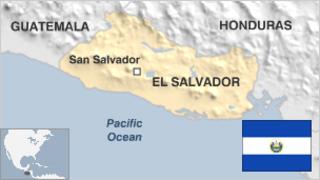Home » Latin America »
El Salvador country profile
El Salvador, the most densely-populated state on the mainland of the Americas, is a small and highly-industrialised country.
In the 1980s, El Salvador was ravaged by a bitter civil war stoked by gross inequality between the overwhelming majority of the population and a small and wealthy elite that left around 70,000 people dead.
A United Nations-brokered peace agreement ended the civil war in 1992, ushering in important political reforms, but the country still suffers from the legacy of a divided society.
Violent “mara” street gangs have left El Salvador with one of the world’s highest murder rates.
FACTS
Republic of El Salvador
Capital: San Salvador
Population 6.3 million
Area 21,041 sq km (8,124 sq miles)
Major language Spanish
Major religion Christianity
Life expectancy 68 years (men), 77 years (women)
Currency US dollar & Salvadoran colon
LEADER
President: Salvador Sanchez Ceren
A former rebel leader, Salvador Sanchez Ceren, won the presidential run-off of March 2014 by a narrow margin.
As presidential candidate of the left-wing Farabundo Marti Liberation Front (FMLN), he beat Norman Quijano of the conservative Arena party by less than a quarter of a percentage point, becoming the first former guerrilla to lead the Central American country.
In his inauguration speech, he promised to fight corruption and violence, and “to serve as president of all Salvadoreans”.
MEDIA
Press freedom is guaranteed under the constitution and there is a lively media scene.
The broadcast media are privately owned and in the hands of a small group of business interests.
TIMELINE
Some key dates in the history of El Salvador:
1540 – El Salvador becomes a Spanish colony after indigenous resistance is crushed.
1821 – Independence from Spain.
1823 – 1840 – El Salvador forms part of the short-lived United Provinces of Central America, which also includes Costa Rica, Guatemala, Honduras and Nicaragua.
1859-63 – President Gerardo Barrios introduces coffee growing.
1932 – Some 30,000 people are killed during the suppression of a peasant uprising led by Agustine Farabundo Marti.
1969 – Football War with Honduras; 4,000 die in 100-hour conflict.
1979 – 1992 – Civil war. Between 1979 and 1981 around 30,000 people are killed by army-backed right-wing death squads.
2009 – Former FMLN rebel movement emerges as largest party in parliamentary elections and shortly afterwards former rebel Mauricio Funes wins presidential elections.
2012 – A year-long truce between street gangs. It reputedly saves the lives of thousands but violence rises again in subsequent years.
Source: Read Full Article



